Inside: Check out 26 creative gravel landscaping ideas that can totally change your outdoor space. Gravel brings texture and color, and it’s super easy to care for.
If you’re looking for a simple way to give your yard a fresh look, gravel landscaping might be just what you need.
You can use gravel to make paths, garden beds, or decorative spots that look great and don’t need much work.
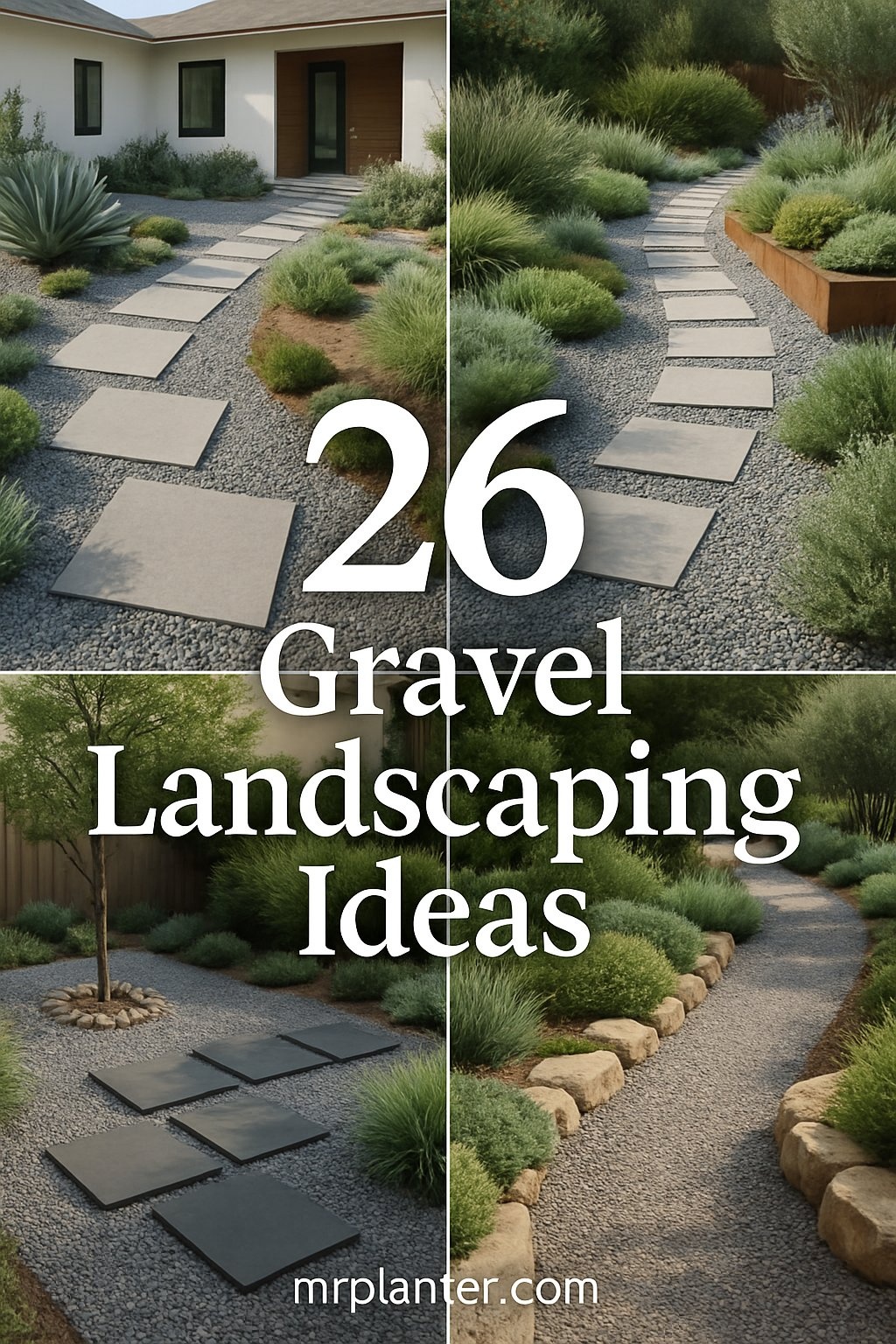
Here are some ideas to help you use gravel in ways that match your style and space.
1. Create a gravel path with stepping stones
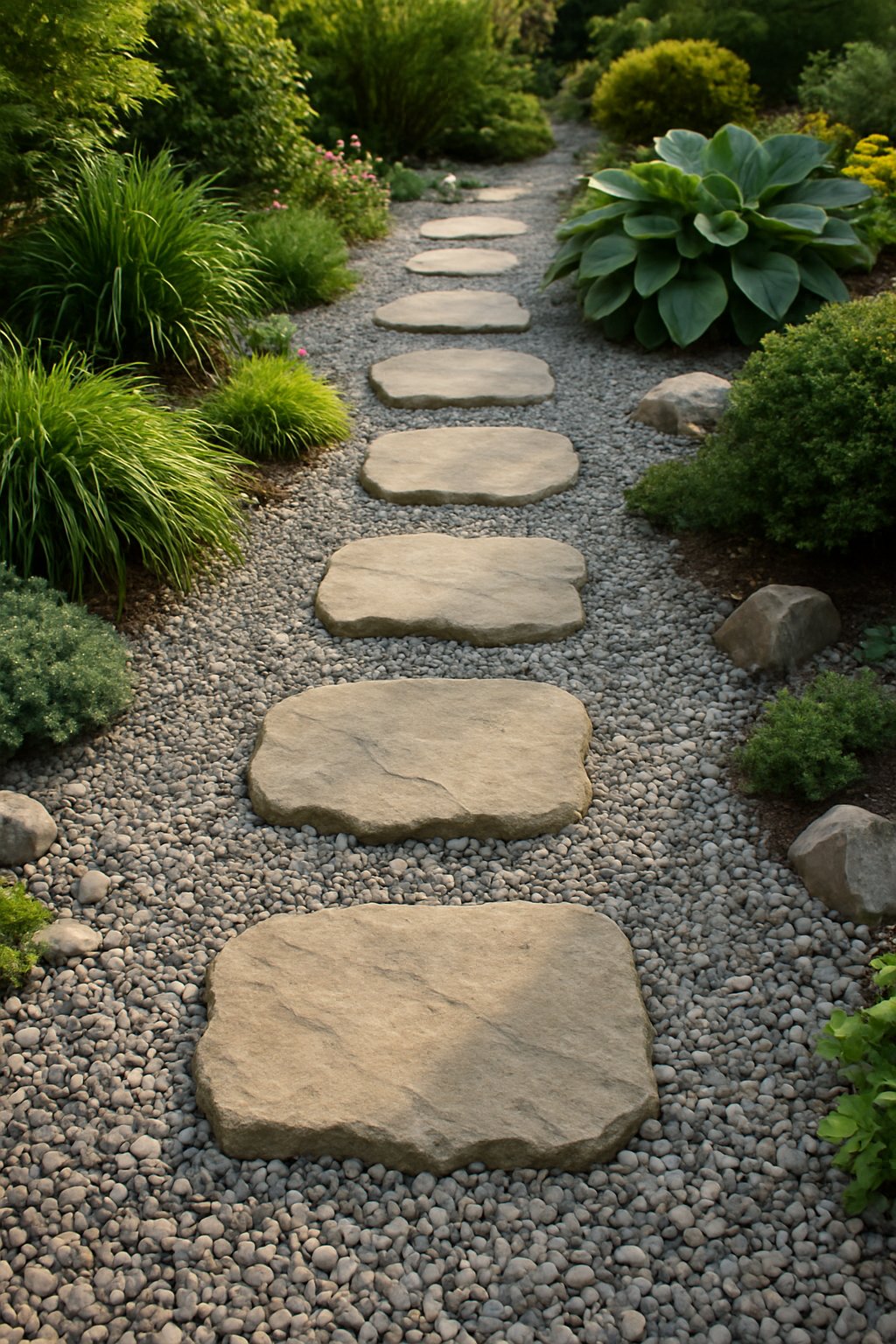
A gravel path with stepping stones brings both charm and function to your yard. Start by figuring out the shape and size you want—straight, curved, or maybe something a bit more natural.
Put down landscaping fabric to block weeds, then pour a layer of gravel for the base. Place stepping stones with some space between them so the gravel shows through.
This combo feels nice to walk on, and it looks even better with plants on the sides. You can pick square, round, or even odd-shaped stones, whatever suits your vibe.
Gravel keeps water from pooling, so your path won’t get muddy. You can choose gravel colors and sizes that go with your yard.
Mixing gravel and stones keeps things tidy and low maintenance all year.
Expert Tip from MrPlanter: “Pick stones that are flat and wide—they’re safer and comfier. Crushed gravel works better than round for stability.”
2. Use reclaimed wood borders around gravel areas

Reclaimed wood makes a fantastic border for gravel spots. It brings a warm, natural look that just fits outdoors.
Old wood often looks weathered, so you get that rustic feel without much effort. You could use old fence posts, barn wood, or even pallet planks.
Wood borders keep gravel from spreading out and define the edges, making everything look neat.
Lay the wood flat or stand it up for a stronger edge. Staining or sealing helps protect it from rot and bugs.
Using wood you already have, or can get cheap, saves money. Plus, it’s a green choice since you’re reusing stuff.
Try mixing up wood sizes or shapes for a border that stands out. It’s an easy way to add character to your garden or driveway.
Check for nails or sharp bits before you put the wood in place. Set the border on a solid base so it stays put.
Expert Tip from MrPlanter: “Pick pressure-treated wood if you want it to last longer. Always seal reclaimed wood to keep the weather out.”
3. Incorporate a gravel fire pit lounge
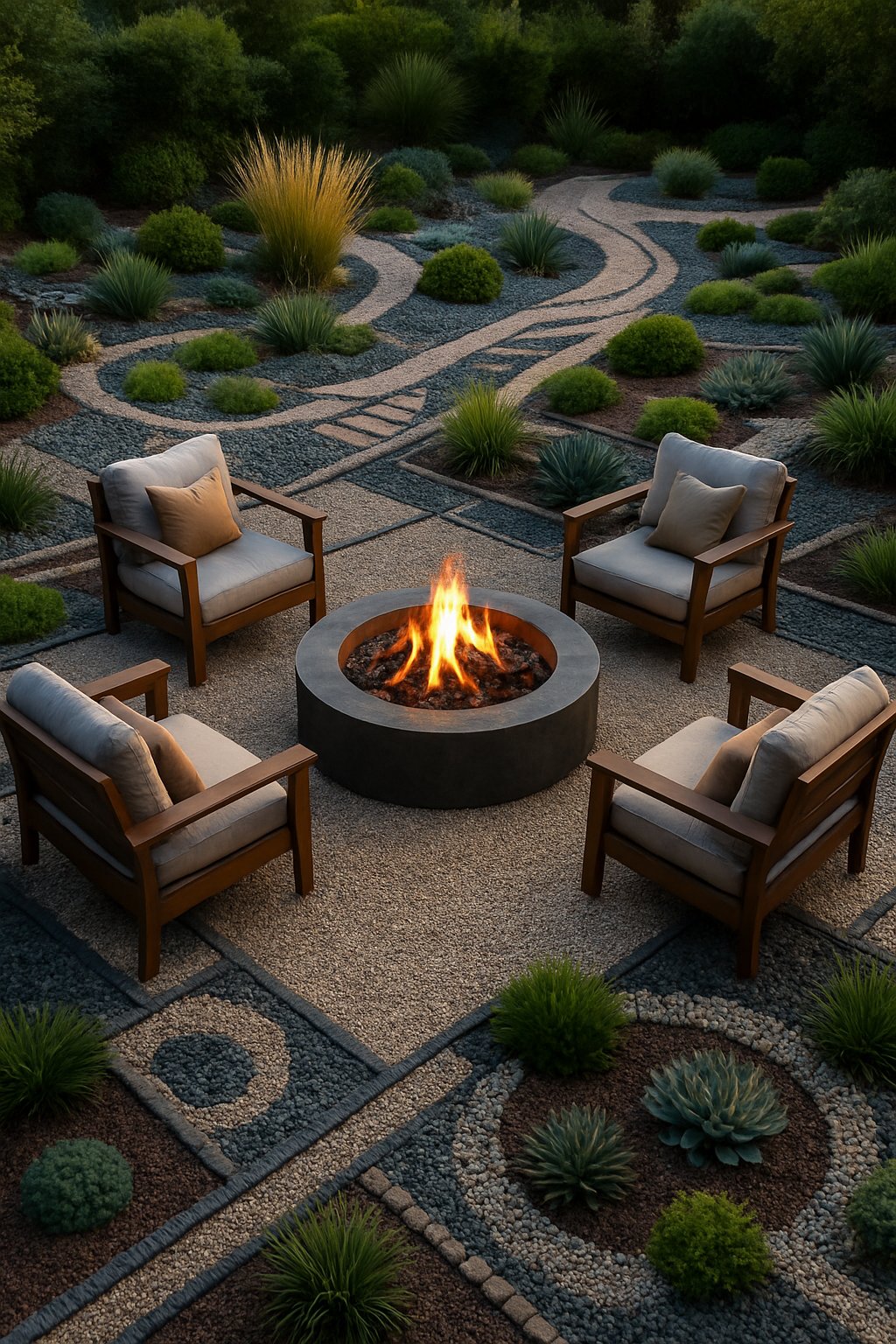
You can set up a gravel fire pit lounge for a cozy hangout spot outside. Gravel drains well and keeps things tidy around the fire.
Try a sunken design if you want it to feel a bit more private. Arrange seating—maybe Adirondack chairs or built-in benches—so everyone faces the fire. Keep the seating simple and let the fire pit steal the show.
Tall grasses or some leafy plants nearby add privacy and soften the look.
Pick gravel that matches your outdoor vibe. Go for small, uniform gravel for a modern look, or use natural stone if you want something rustic.
Make sure there’s enough space around the fire pit for safety.
Expert Tip from MrPlanter: “Add drainage under your fire pit so water doesn’t collect. Use non-flammable seating materials for safety.”
4. Mix gravel with succulents and cacti
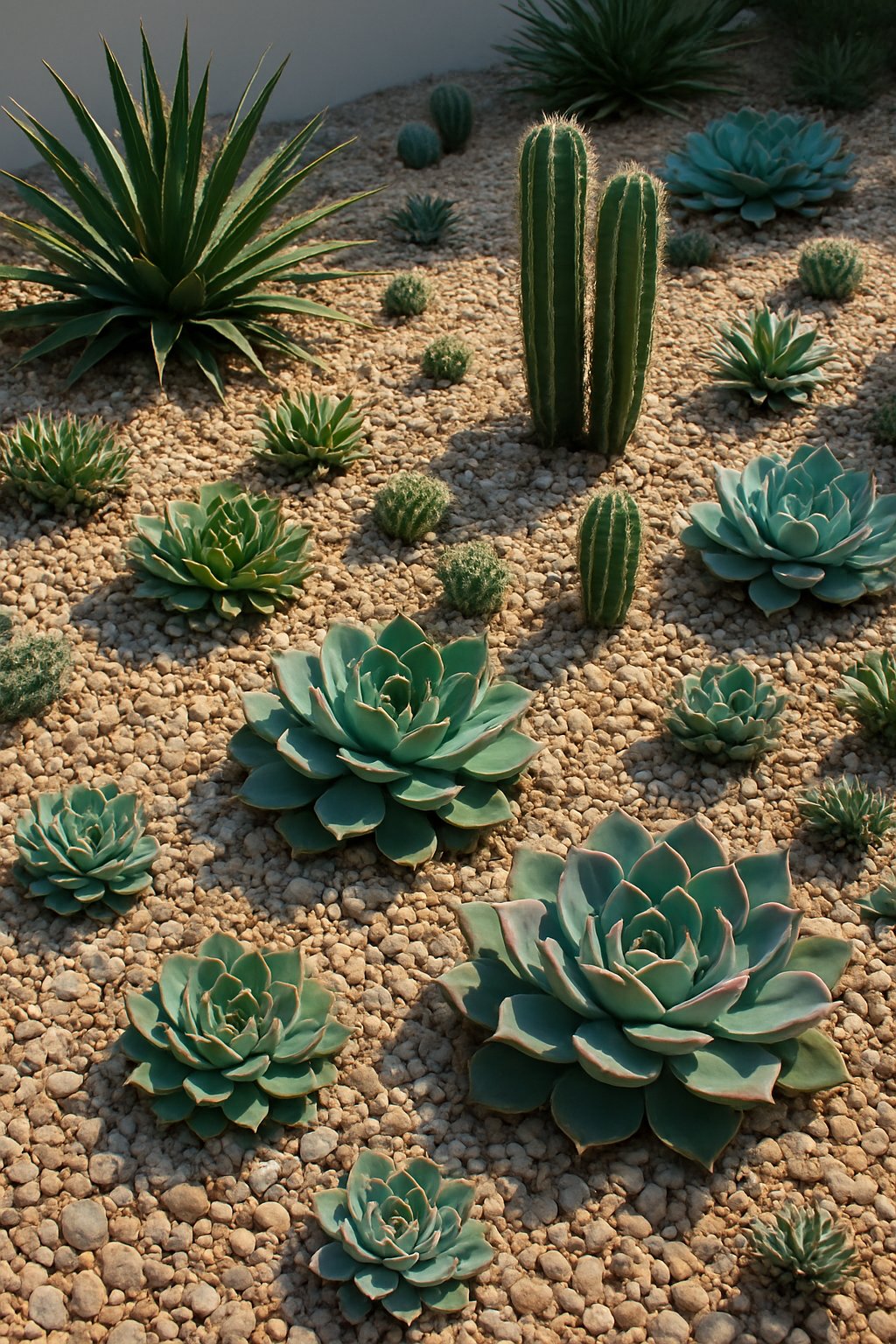
If you use gravel with succulents and cacti, you’ll get a natural, desert-like look. Gravel helps drain water, which these plants really need.
Too much water can hurt them, so gravel keeps things dry. Mix gravel into the soil or spread it as a top layer.
This stops soil erosion and helps your plants stay healthy. Try out different gravel colors and sizes for more texture and contrast.
Gravel also cuts down on weeds and keeps everything looking tidy. Your succulent or cactus garden will look sharp and clean without a ton of effort.
Expert Tip from MrPlanter: “Put gravel on top to protect roots and boost drainage. Choose gravel colors that make your plants pop.”
5. Design a dry garden with gravel and rocks

You can build a dry garden with gravel and rocks for a low-maintenance landscape. It’s perfect for sunny spots and saves water.
Mix different gravel sizes with bigger rocks for more texture. Pick drought-tolerant plants like succulents or native shrubs that don’t need much water.
Arrange them around the rocks for a natural effect. Pull out all the weeds before you lay down gravel so the garden stays clean.
You can even add a dry creek bed to guide water and make things interesting.
Gravel cuts down on weeds and helps water drain. It gives your yard a neat, tidy look.
Expert Tip from MrPlanter: “Pick plants that fit your climate to make care easier. Fill gaps with gravel to keep weeds away naturally.”
6. Add crushed granite gravel for walkways
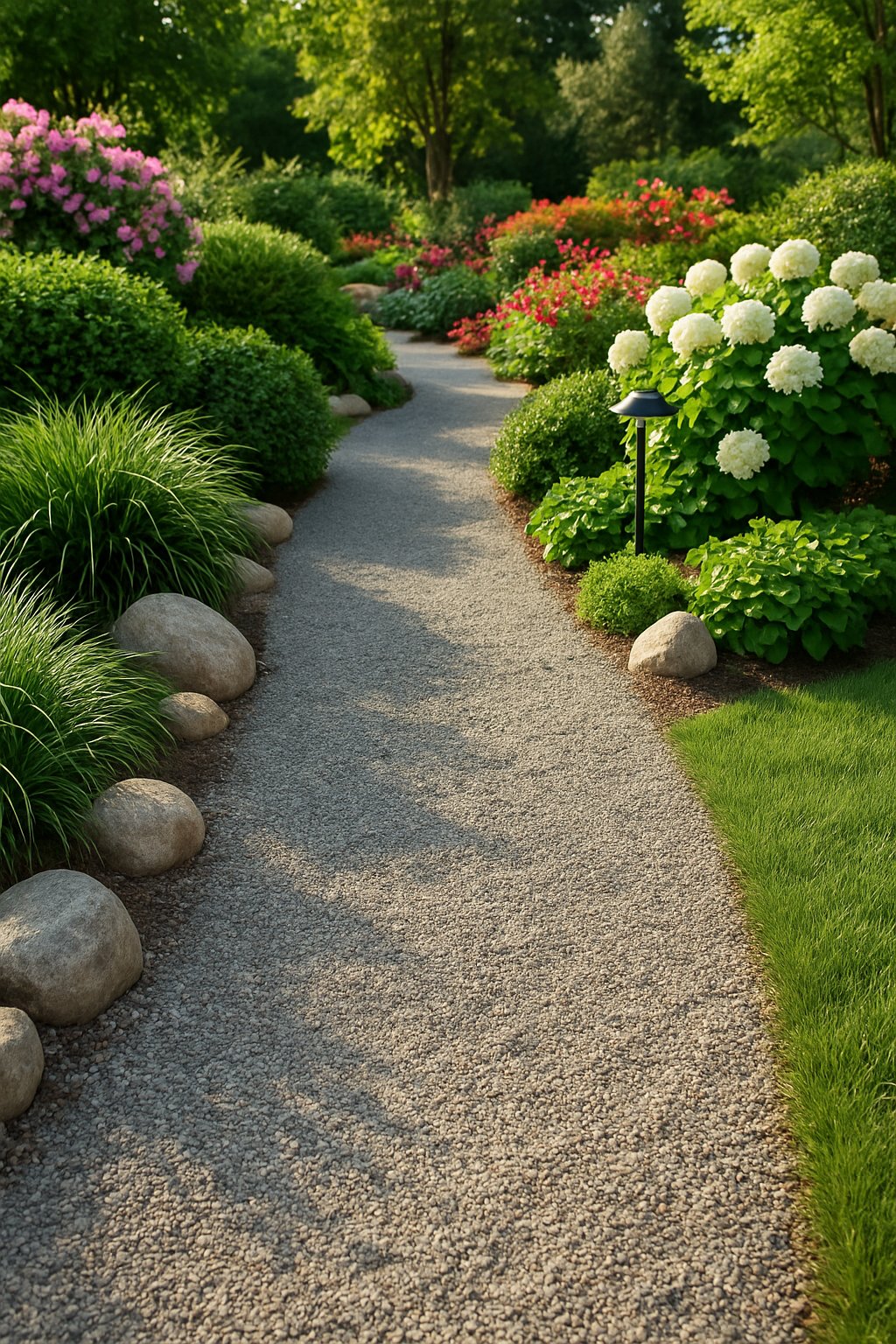
Crushed granite gravel works really well for walkways. It gives you a firm surface that stands up to lots of foot traffic.
You can spread it easily and shape the path any way you want. This gravel packs down nicely for a smooth, stable walk.
Before you add crushed granite, put down landscape fabric to stop weeds. Dampen the gravel a bit to help it settle and keep dust down.
Crushed granite comes in different colors, so you can match it to your garden style. It looks great with natural elements like plants and rocks.
If your path gets thin, just add more gravel to freshen it up.
Expert Tip from MrPlanter: “Use a hand tamper to pack down the gravel in small sections. Spray water as you go to keep dust low and make it sturdier.”
7. Build raised beds with gravel mulch

You can build raised garden beds and use gravel as mulch to keep things tidy. Gravel holds in moisture and blocks weeds, making your garden easy to manage.
Start by building the raised bed with wood or stone, then fill it up with good soil. After you plant, spread gravel over the soil and around the bed edges and paths.
Pick gravel colors that go with your garden for a nice touch. Gravel works for flowers, herbs, and drought-tolerant plants.
It’s low maintenance and lasts a long time.
Build beds 12 to 36 inches high for most plants. Taller beds make gardening easier and let you grow more types of crops.
Expert Tip from MrPlanter: “Use pea gravel for mulch—it drains well and doesn’t wash away easily. Make sure to use good soil under the gravel for the best plant growth.”
8. Use colored gravel to highlight garden zones

Colored gravel is a fun way to mark off different areas in your garden. Try bold colors to split up a play zone from a sitting area.
This makes your garden feel organized and easy to navigate.
Pick colors that stand out against your plants. For example, white gravel looks great near dark green bushes.
You can also mix colors for patterns or borders around flower beds.
Colored gravel adds personality without needing extra plants or decorations. It helps guide people along paths or toward features like benches.
Since gravel is low maintenance, the color keeps looking good for a long time.
Try shades that fit your home’s style or match the season. Blues and grays feel calm, while reds and yellows bring energy.
Expert Tip from MrPlanter: “Use colored gravel on paths to guide movement. Pick shades that work with nearby plants for a balanced look.”
9. Make a Japanese Zen gravel garden
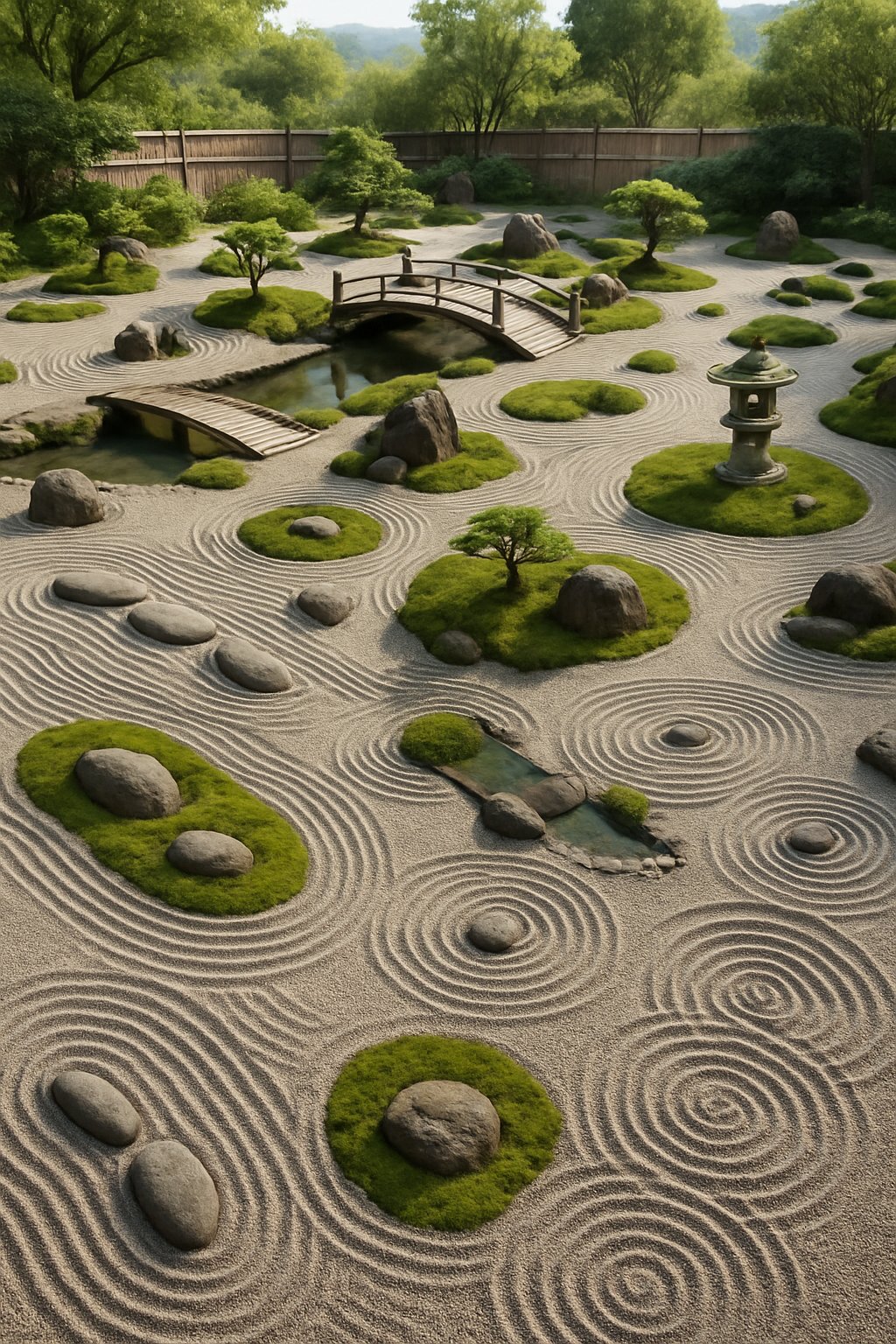
You can set up a calm space with a Japanese Zen gravel garden. Start with a flat spot and cover it with fine gravel or sand.
Use a rake to create simple patterns—think waves or ripples.
Add a few large stones for balance and interest. Mix up the rock sizes for a natural look.
Keep plants to a minimum, maybe a little bamboo or dwarf pine, to stick with Zen style.
This kind of garden helps you relax while you rake and keeps your yard looking tidy. It works in big or small spaces.
Expert Tip from MrPlanter: “Go for pale gravel so your rake patterns show up clearly. Choose rocks with smooth edges for a more natural feel.”
10. Use pea-sized pebbles for texture contrast
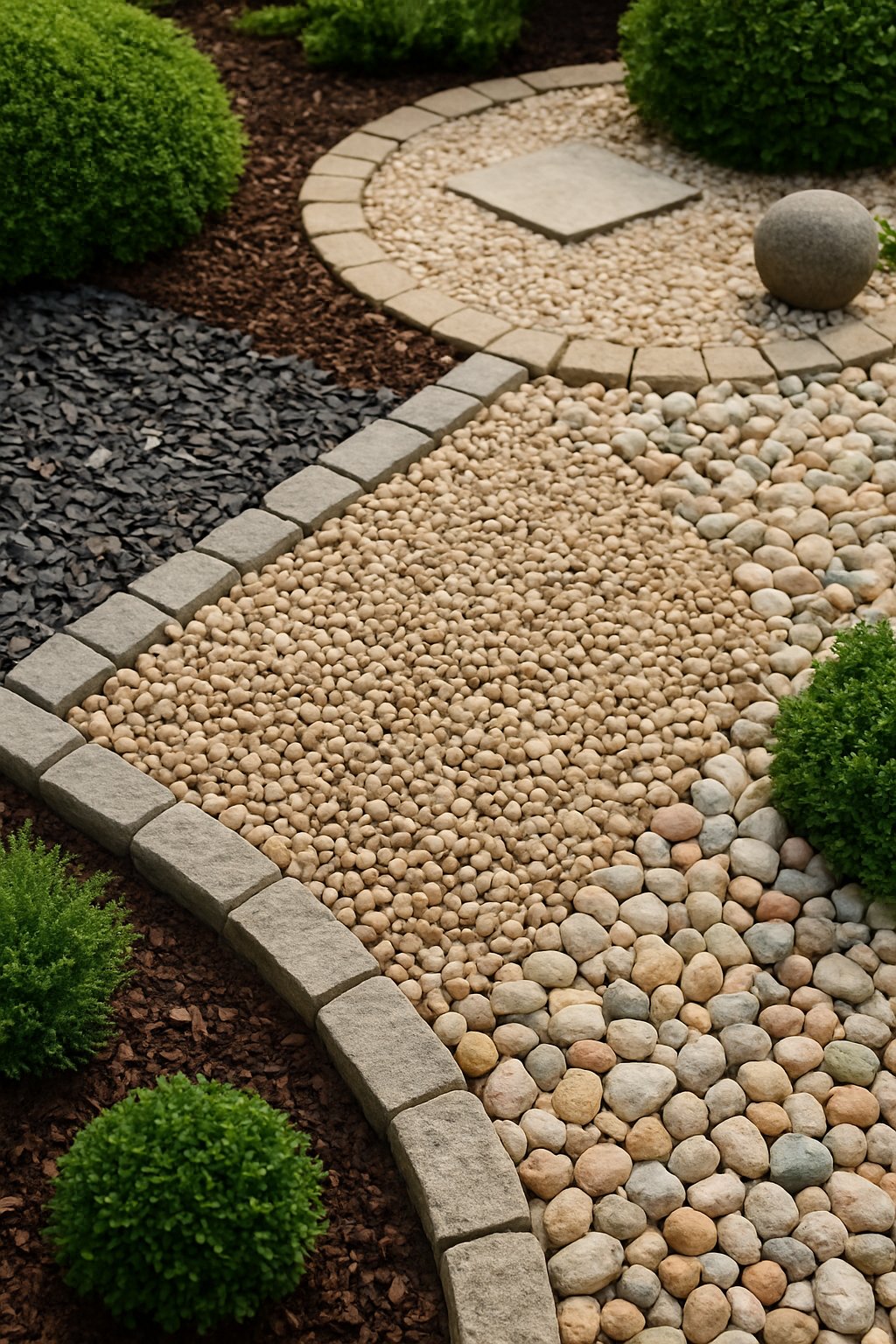
Pea-sized pebbles add a soft, rounded texture that looks great next to hard edges like concrete or wood. They make a smooth surface that stands out against sharper plants or rough rocks.
This mix of textures makes your garden feel more interesting.
Use pea gravel to fill gaps between stepping stones or line flower beds.
It works well for paths because it’s comfortable to walk on and drains nicely. The small stones keep the surface stable but let water flow through.
Mixing pea gravel with other materials lets you show off colors and shapes in your garden. It also helps cut down on mud in wet spots, and you won’t have to do much upkeep.
Adding pea-sized stones is a simple way to get both style and function.
Expert Tip from MrPlanter: “Spread pea gravel evenly and tamp it down a bit so it stays put. Adding a border helps keep the stones where you want them.”
11. Combine gravel with water features
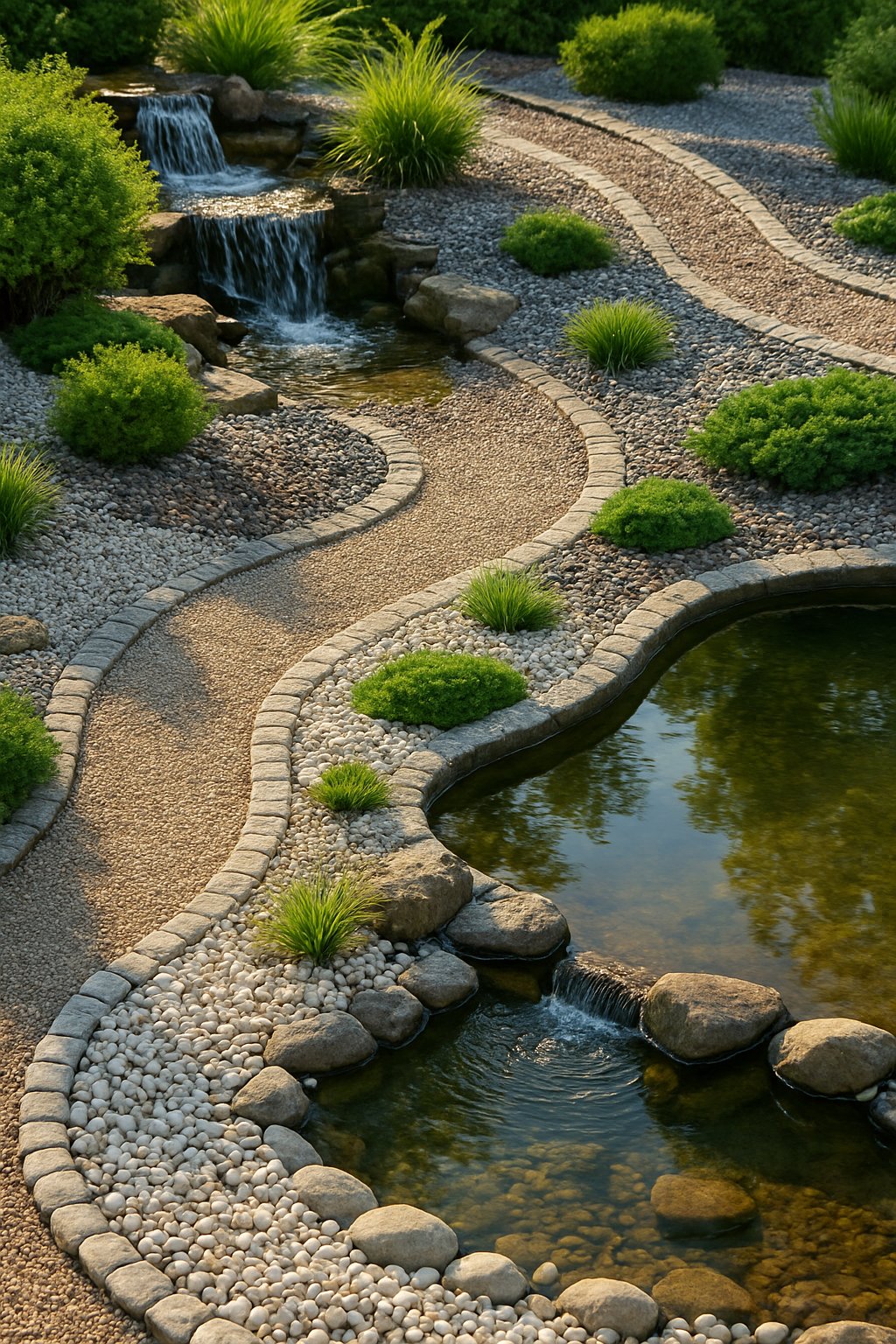
Try adding gravel around water features like ponds or fountains to give your yard a more natural vibe. Gravel defines the space and keeps mud and dirt down, so the area stays cleaner.
Pick gravel colors that pop against the water if you want some contrast. I usually go with medium-sized gravel since it doesn’t scatter much when people walk by.
Gravel helps water drain away, so you won’t get puddles around your pond or fountain. If you tuck small plants among the gravel, the spot feels calmer and more colorful.
Surround a small stream or waterfall with gravel to boost the soothing sound of moving water. Honestly, it just makes the whole space more relaxing.
Expert Tip from MrPlanter: “Use gravel that matches the style of your water feature for a seamless look. Avoid very fine gravel near water to keep the area neat and low maintenance.”
12. Use river stones to complement gravel
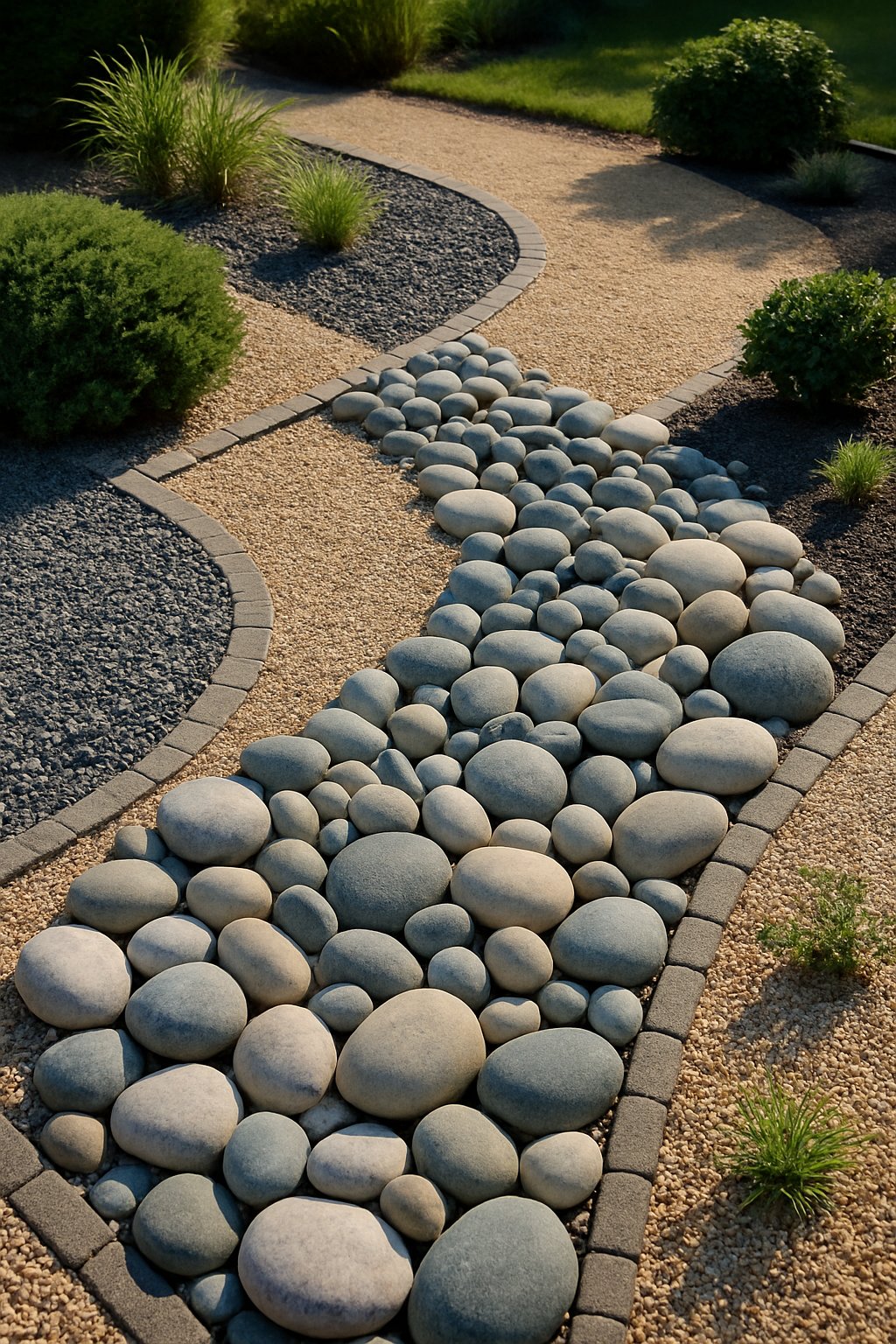
River stones bring smooth shapes and natural colors that really work well with gravel. Mix them along pathways or at the edges of your garden to balance out the textures.
The contrast between rough gravel and polished river stones makes things feel more interesting. I like using river stones as a border around gravel beds to keep everything tidy.
That border helps with drainage and stops the gravel from spreading too far. It also separates different parts of the garden, which keeps things organized.
Try combining different sizes and colors of river stones with gravel for extra depth. You don’t always need more plants or decorations—sometimes this simple combo does the trick.
Expert Tip from MrPlanter: “Use river stones to outline key features in your landscape for a clean, polished look. Combine stones of varying sizes for a natural and dynamic effect.”
13. Create a gravel courtyard for outdoor seating

A gravel courtyard is honestly one of the easiest ways to build a cozy outdoor seating spot. Just spread gravel over a level base to make a stable surface that drains well.
This keeps things dry and low-maintenance. Add benches, chairs, or a little table to make it feel welcoming.
Surround your seating with potted plants or low shrubs for greenery that doesn’t need much care. Gravel’s neutral color makes your furniture and decorations stand out.
If you want to boost comfort and style, try tossing in a fire pit or some lanterns. Pick your gravel size based on the vibe you’re after.
Larger stones give a rustic feel, while smaller gravel creates a cleaner look.
Expert Tip from MrPlanter: “Use edging to keep gravel in place and maintain a neat shape. Pick plants that thrive in dry soil for easier care around your seating.”
14. Add gravel around native drought-tolerant plants

Put gravel around native drought-tolerant plants to help with drainage and keep roots happy. Gravel stops water from pooling, which these plants usually hate.
Spread 4 to 5 inches of gravel around the plants for good airflow, and it keeps the soil from drying out too fast. This setup works best for deep-rooted plants that want sharp drainage.
Gravel also cuts down on weeds and makes maintenance easier. Native plants—think prairie species—do great with this because they’re used to dry, tough spots.
Make sure you keep roots moist when first planting until they settle in. Gravel outlasts mulch and doesn’t need replacing all the time.
If your area gets heavy rain, use landscape cloth under the gravel. That keeps it from sinking into soft soil.
Expert Tip from MrPlanter: “Water new plants well until roots grow deep. Gravel will protect them after they’re established.”
15. Install gravel driveways with edging
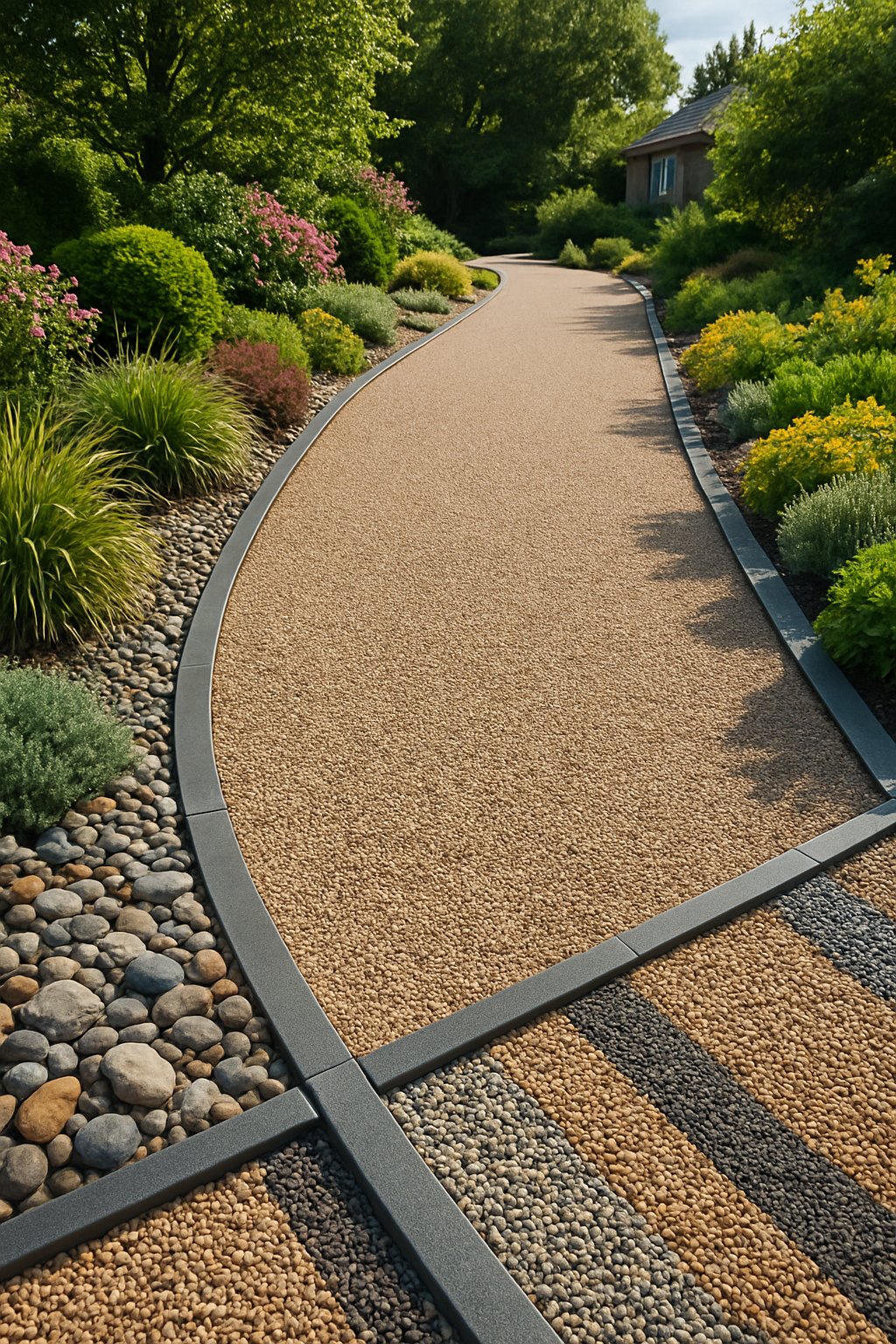
Add edging to your gravel driveway to keep the gravel tidy and in place. You can pick materials like brick, wood, rubber, or metal for the edging, and each gives a different look.
Timber edging is simple to install and feels natural. Brick edging looks polished and comes in lots of colors.
Rubber or metal edging is flexible and low-maintenance, especially for curves. Edging keeps gravel off sidewalks and lawns, making your driveway look finished.
It can even boost your home’s curb appeal with a clean border. Choose edging that fits your style and budget.
Just make sure it’s sturdy enough to hold the gravel in place over time. Proper edging keeps your driveway’s shape and saves you work later.
Expert Tip from MrPlanter: “Pick edging that suits the rest of your yard’s design. Always dig deep enough so it holds in place and stays strong long-term.”
16. Layer gravel with mulch for weed control

Try layering mulch on top of gravel to keep weeds under control. Mulch blocks sunlight, so weeds have a tougher time popping up.
This also adds a nice mix of textures and colors to your garden. Using mulch over gravel does take a bit of upkeep.
You’ll need to add more mulch now and then to keep the barrier thick. That keeps weed control strong and your landscaping fresh.
Mulch helps the soil under your gravel stay healthy and supports soil life for better plant growth. Pick mulch that contrasts with your gravel for a crisp, clean look.
Expert Tip from MrPlanter: “Use natural mulch like bark or wood chips for longer-lasting weed control. Replace it seasonally to keep your gravel area looking sharp and weed-free.”
17. Use gravel as filler for sloped yards
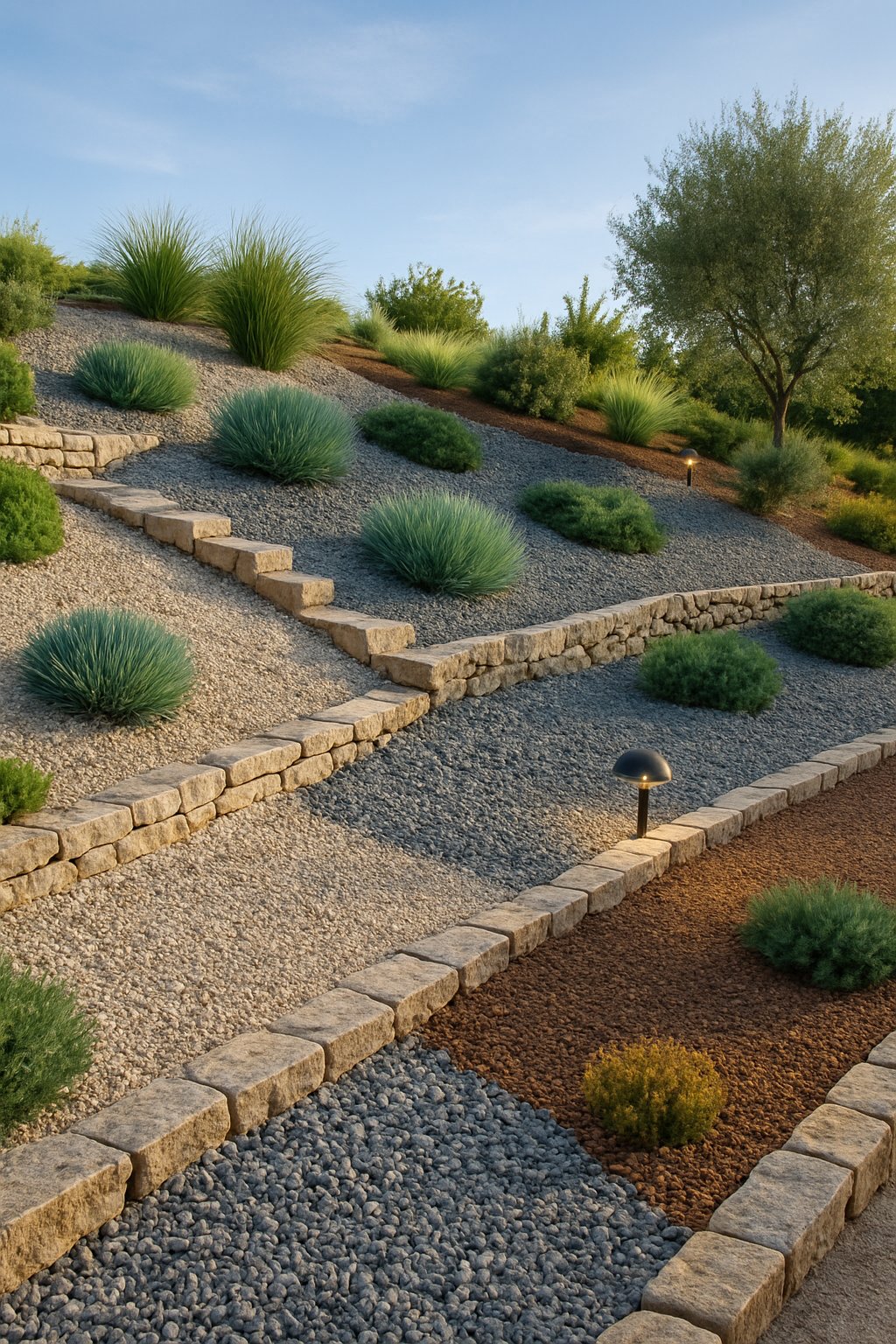
Gravel works great on sloped yards because it helps water drain away instead of pooling. This keeps your soil and plants safer.
Layer gravel for more stability. Start with a bigger base layer—gravel about ¼ to 1½ inch wide—then top it with finer gravel around ⅛ to 1½ inch for good coverage.
Gravel cuts down on erosion and holds soil in place. You can use landscaping timbers or rocks to build retaining walls or borders that hold everything together.
Plant some herbs or flowers between the gravel and rocks for color and scent. This combo keeps your yard neat and really low-maintenance.
Expert Tip from MrPlanter: “Start with a solid base layer to keep the gravel stable over time. Mix plants with your gravel to brighten the slope and make it feel alive.”
18. Make a Mediterranean-inspired gravel patio
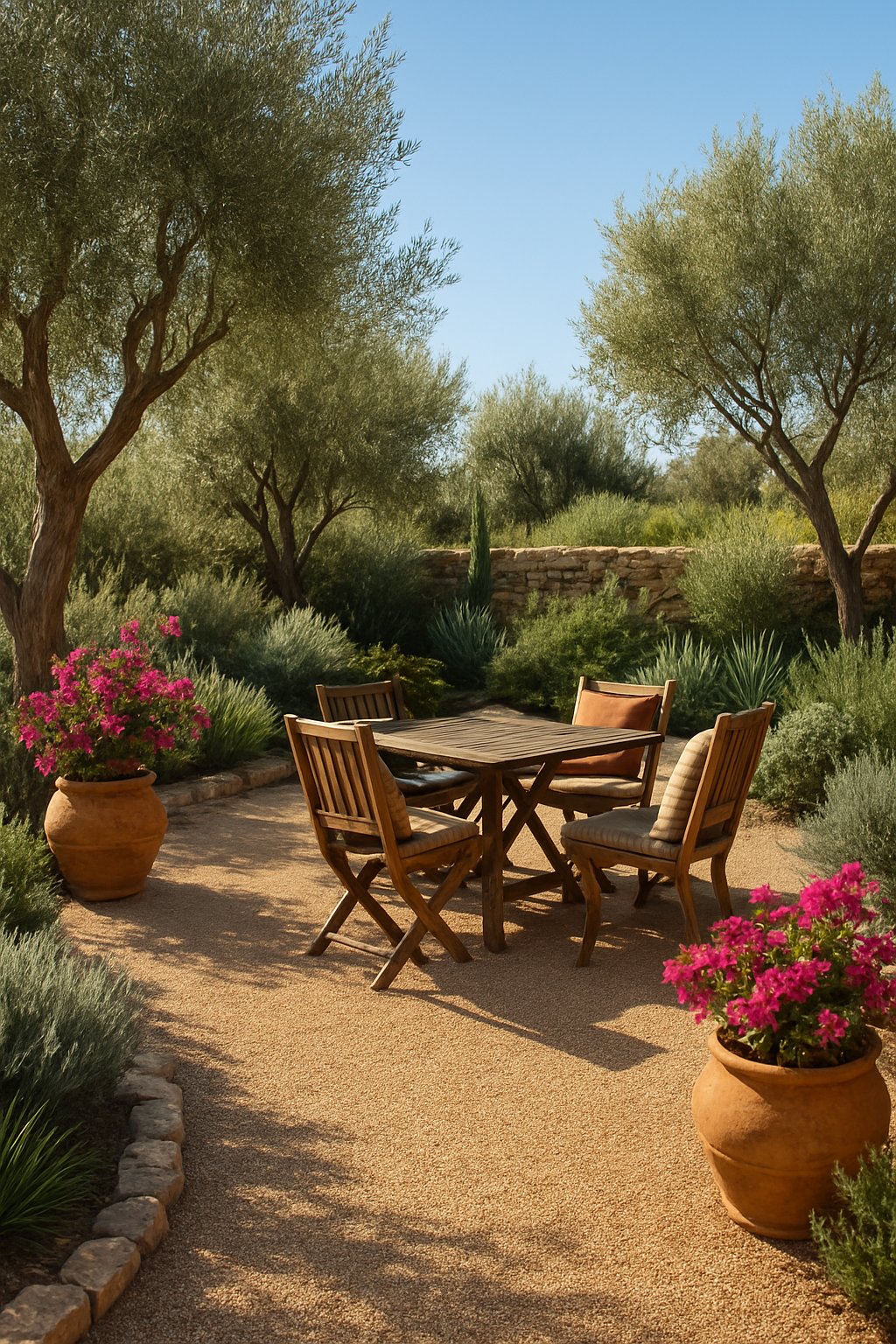
Go for a Mediterranean-inspired gravel patio by picking warm-colored gravel like terracotta or tan. These shades give your patio a sunbaked, cozy feel that’s hard to beat.
Add natural touches like weathered wood benches or stone pots for a rustic, authentic vibe. Surround the patio with drought-resistant plants—olive trees, lavender, and succulents are all good choices.
They bring in greenery without much watering. String lights or lanterns brighten things up in the evening and add that laid-back Mediterranean atmosphere.
Mix in cobblestones or pea pebbles for more texture and interest. Breaking up the gravel area with these makes it feel more put-together.
Expert Tip from MrPlanter: “Keep your gravel layer thick enough to prevent weeds and maintain drainage. Incorporate a mix of textures like gravel, stones, and wood to keep the space dynamic and natural.”
19. Place large landscaping rocks with gravel
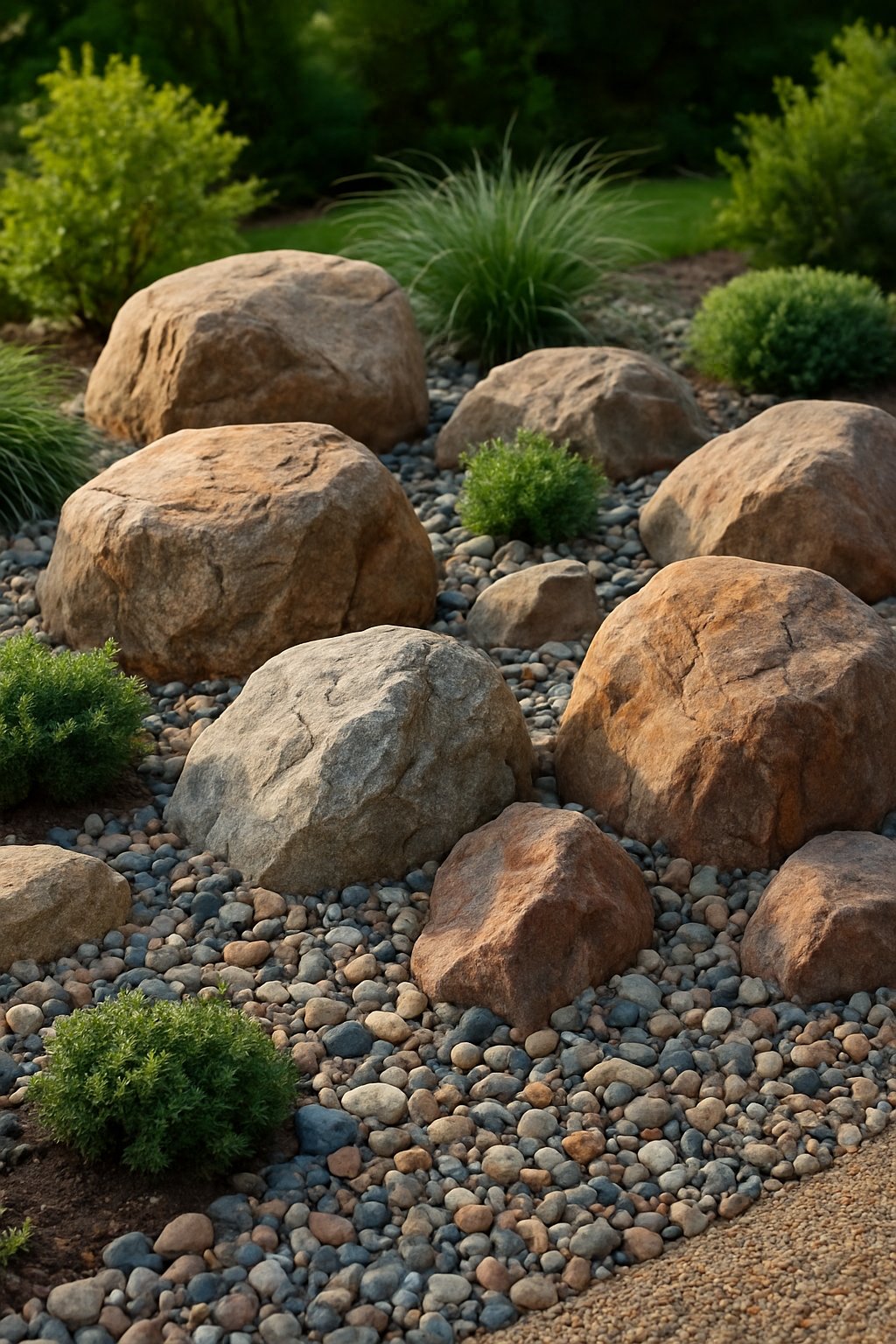
Try using large rocks with gravel to add structure and a bit of drama to your yard. Lay down small gravel first for a clean, even base.
Then, set bigger rocks on top to draw the eye and create natural focal points. You can group the rocks or scatter them for a looser look.
Mixing gravel with large stones helps with drainage and stops soil from eroding. This works nicely for paths, dry creek beds, or along garden borders.
Stack a few rocks to make a low wall or planter base. This adds height and visual layers and makes your landscape more interesting.
Expert Tip from MrPlanter: “Place rocks where they can catch the most natural light to create shadows and texture. Mix different sizes to avoid a uniform look.”
20. Create gravel garden paths with curves
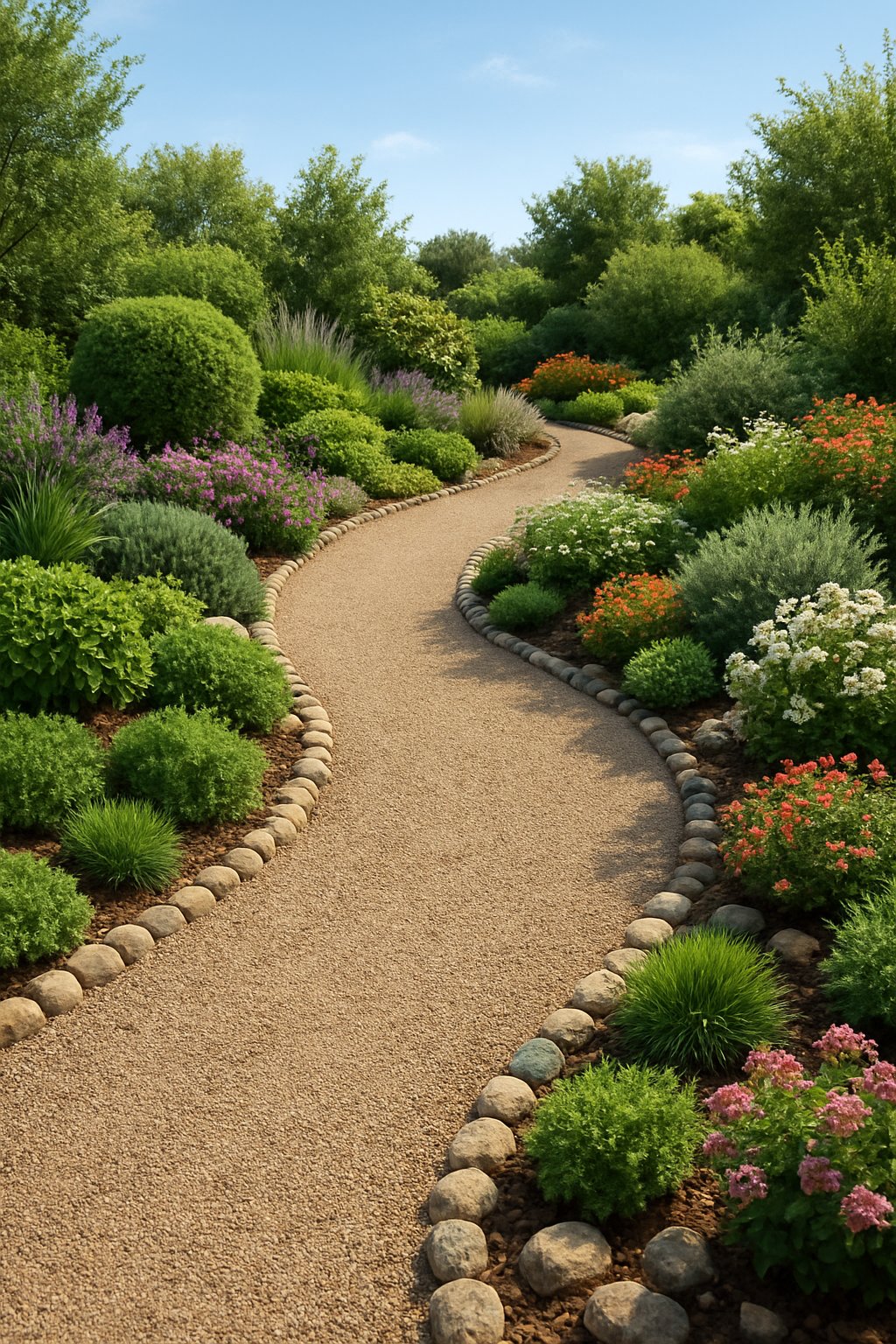
Curved gravel paths bring a natural, laid-back flow to your garden. They break up straight lines and make the space feel softer.
A gentle curve encourages visitors to wander and discover new spots in your yard. Use stone or plants as edging to keep the gravel neat and show off those curves.
Curves also let you plant along the sides, so you can mix colors and textures for a prettier path. Gravel paths with curves are easy to install and you can tweak the shape later if you want.
Using local or recycled gravel saves money and still gives you a solid, attractive path.
Expert Tip from MrPlanter: “Use landscape fabric under the gravel to stop weeds and keep your path tidy. Shape your curves first with a garden hose to visualize before digging.”
21. Use gravel to improve garden drainage

Gravel lets water drain away from your plants and keeps soil from getting too soggy. When you use it in garden beds, it creates little gaps that help water flow through fast.
If your soil feels heavy or clay-like and tends to hold water, gravel really comes in handy. You can put a layer of gravel under the soil to build a drainage base.
This stops water from pooling around your plant roots and helps avoid root rot. Some people even mix gravel right into the soil to make drainage better and give roots more space to grow.
Gravel works around walkways or patios too. It directs rainwater away from your garden beds so your plants don’t get swamped.
Expert Tip from MrPlanter: “Add a thin layer of landscape fabric beneath gravel to stop soil from mixing in. This keeps drainage clear for longer.”
22. Mix gravel with drought-resistant flowers
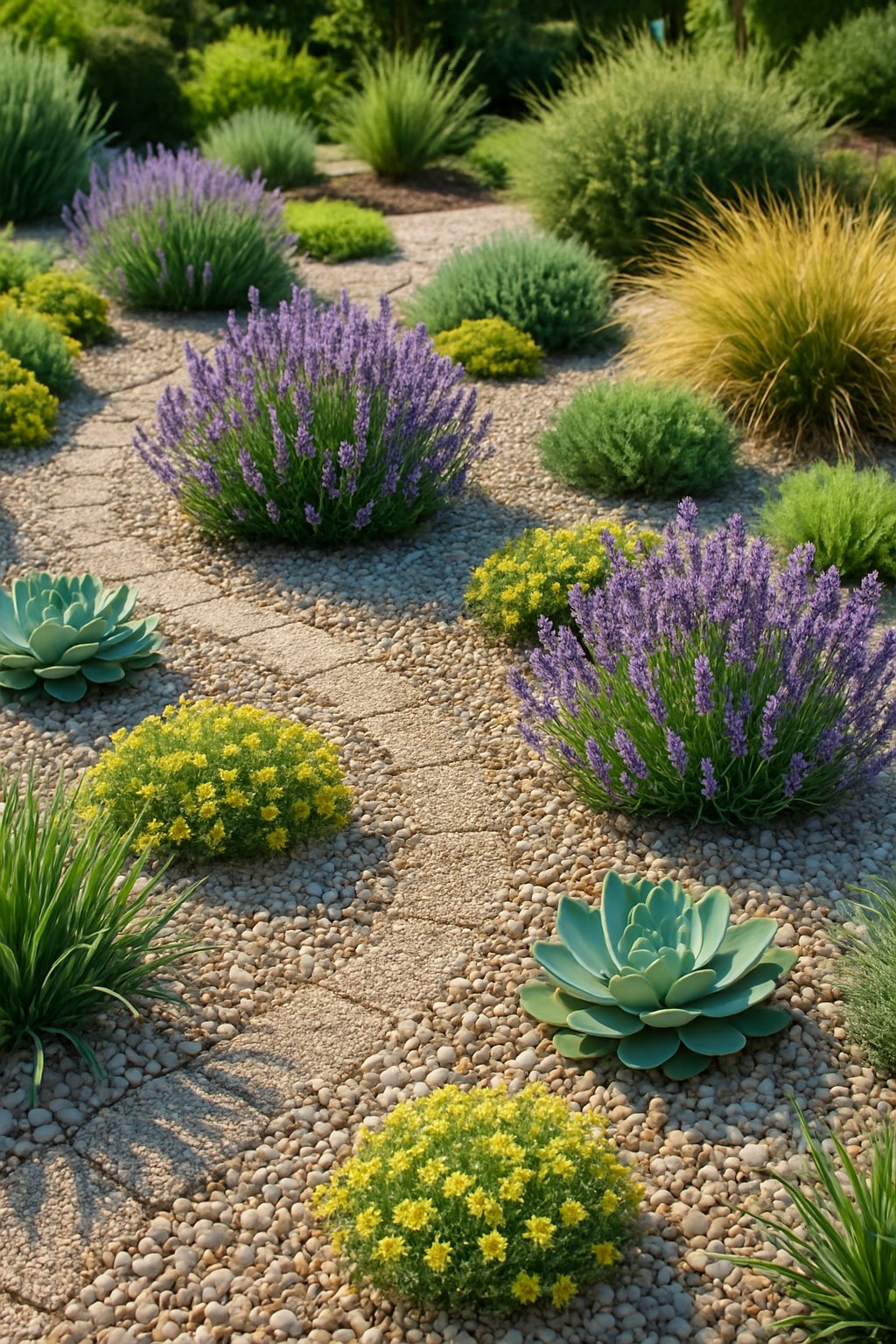
When you pair gravel with drought-resistant flowers, your garden needs less water and care. Gravel drains water quickly, which is perfect for plants that hate soggy roots.
Try flowers like lavender, yarrow, or sedum if you want color and texture. You can group the flowers or scatter them around the gravel, depending on your style.
The rough look of gravel actually makes soft, blooming plants stand out more. It keeps your garden tidy but still feels inviting and a bit wild.
Before you add gravel and plants, pull out any weeds hiding in the soil. This step saves you a lot of trouble later and helps your drought-resistant flowers settle in.
Expert Tip from MrPlanter: “Choose flowers that bloom at different times for constant color. Use mulch under gravel to keep soil moist longer and prevent weeds.”
23. Line gravel areas with solar lights
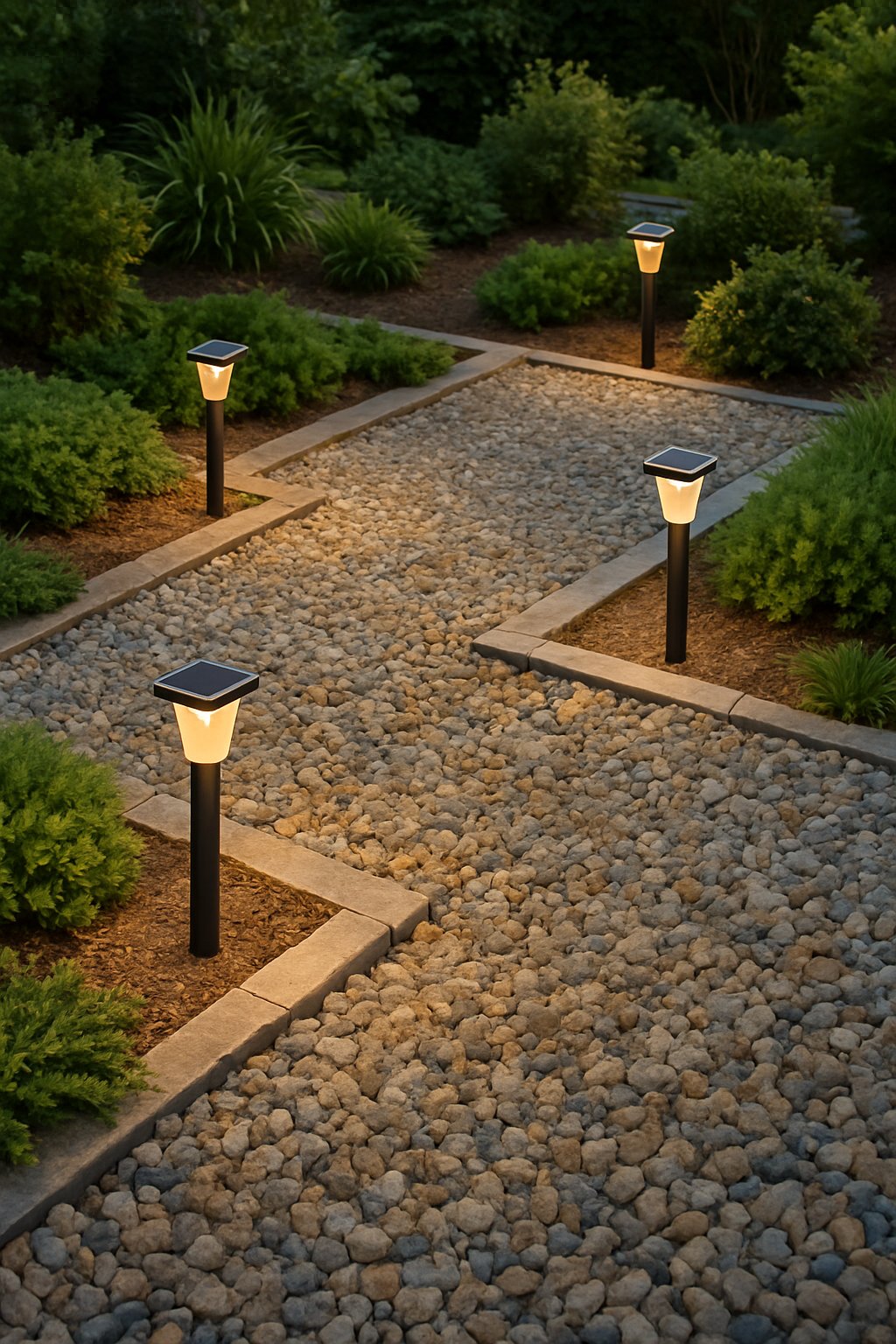
Solar lights along gravel paths or garden edges add a gentle glow at night. You won’t need to mess with wires—just stick them in sunny spots and let them charge up.
Solar lights help make your garden safer by lighting walkways, and they show off the gravel’s color and texture after dark. Pick lights that fit your vibe, whether that’s modern stakes or cozy lanterns.
Spacing matters. Place lights about 4 or 5 feet apart for a balanced look.
You can sneak a few spotlights into low shrubs for extra depth. This way, you guide visitors and set the mood at the same time.
Choose sturdy, weatherproof solar lights so they last through rain and wind. Keeping them clean is easy—just wipe the panels and clear off any leaves or dirt.
Expert Tip from MrPlanter: “Place solar lights where they get direct sun for at least 6 hours a day to ensure brightness all night. Group your lights in layers—some on the path and others tucked in plants—to add more interest.”
24. Add gravel to create a minimalist modern yard
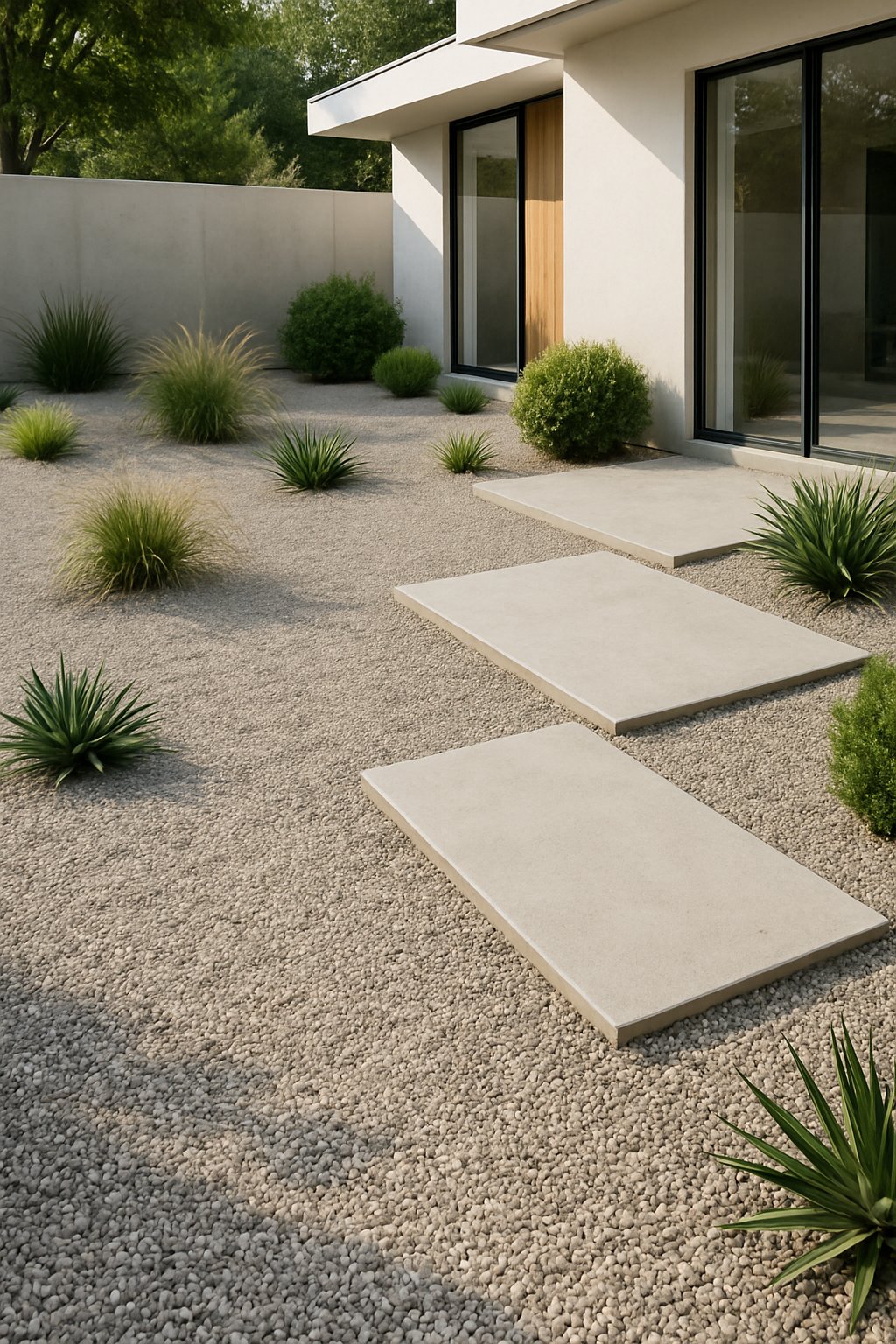
Gravel can totally change your yard, giving it a clean, simple vibe. Spread it out evenly for a smooth look that keeps weeds down and cuts back on chores.
You might want to lay out straight paths or gentle curves with gravel. It’s easy to guide guests through your space this way.
Pair gravel with a few plants or big stones to add texture without making things busy. Gravel works best with neutral colors and modern shapes, so the space feels calm and open.
It also helps you mark out different spots, like seating areas or garden beds, without using heavy borders.
Expert Tip from MrPlanter: “Choose gravel colors that match your home’s exterior for a unified look. Use edging to keep gravel neat and prevent it from spilling over.”
25. Use gravel in raised fire pit surrounds

Gravel around a raised fire pit adds style and makes your outdoor space more practical. It drains water away, so you don’t end up with puddles by the fire.
The look is clean and simple, letting the fire pit stand out. Choose gravel colors that either match or contrast with your fire pit for a cool effect.
Gravel cuts down on flammable plants near the fire, so it’s safer. It also keeps the ground steady for chairs or walking.
Surround your fire pit with a good layer of gravel to stop mud and dirt from spreading around. It’s a lifesaver during rainy weather.
Expert Tip from MrPlanter: “Use pea gravel for a smooth, comfortable surface around raised fire pits. Always check drainage to keep the area dry and safe.”
26. Scatter gravel around herb garden beds
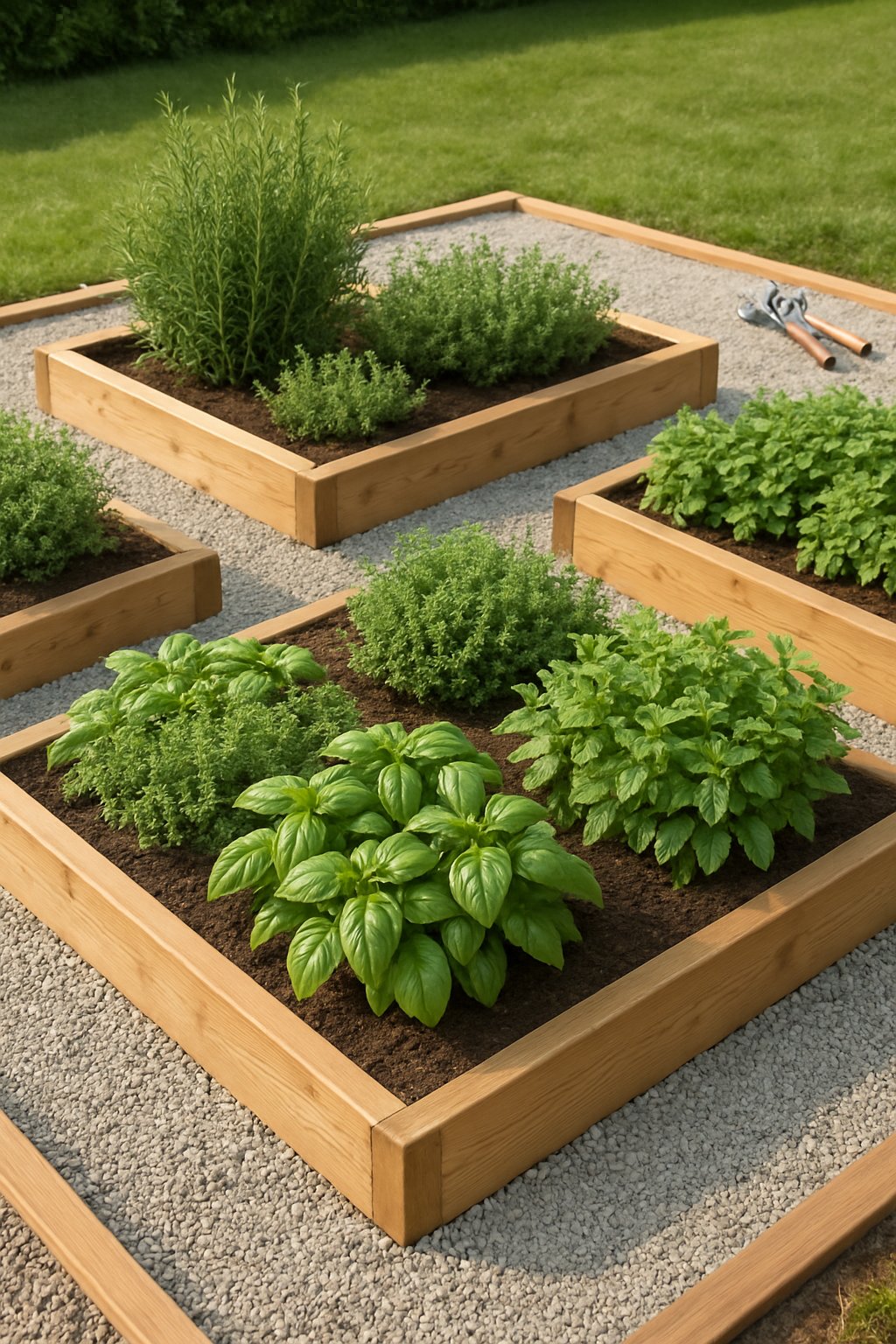
Tossing gravel around your herb garden beds really cuts down on weeds. Plus, it gives the whole area a crisp, tidy vibe that lets your herbs take center stage.
Gravel also boosts drainage, and honestly, herbs hate soggy roots. You can pick gravel colors that either blend in or pop against your plants—totally up to you and your taste.
Walking around your beds gets way easier since gravel keeps your shoes clean and mud-free. You might even find you need less mulch, since gravel won’t wash away or tempt pests like mulch sometimes does.
Spread the gravel evenly, but don’t crowd the plant stems—leave a few inches of space. That little gap helps keep moisture from building up and messing with your herbs.
Expert Tip from MrPlanter: “Go for fine gravel so you don’t end up with sharp bits slicing into your herbs. And hey, give the gravel a refresh each year so drainage stays solid and your garden keeps looking sharp.”

